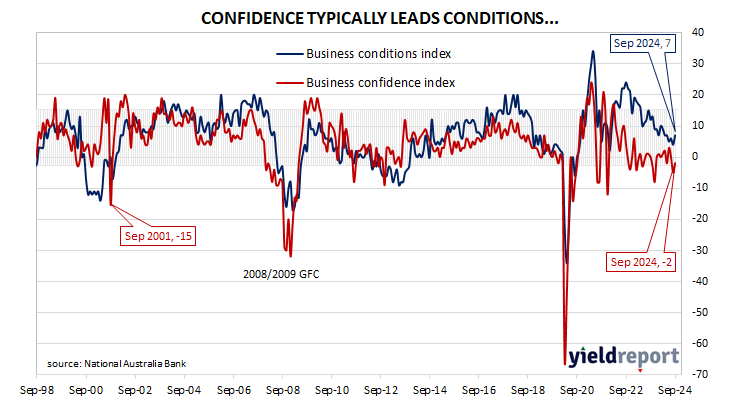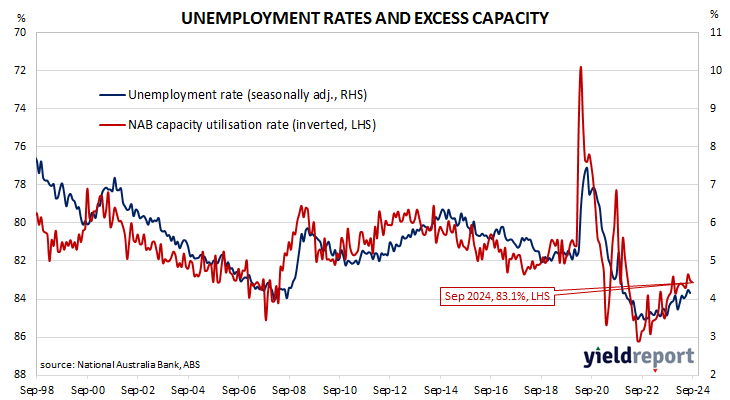Summary: Business conditions improve in September; business confidence also improves, still well below average; NAB: some encouraging signs for soft landing; ACGB generally fall; rate-cut expectations firm; Westpac: tentative signs business conditions finding a floor; capacity utilisation rate rises, at elevated level.
NAB’s business survey indicated Australian business conditions were robust in the first half of 2018, with a cyclical-peak reached in April of that year. Readings from NAB’s index then began to slip and forecasts of a slowdown in the domestic economy began to emerge in the first half of 2019 as the index trended lower. It hit a nadir in April 2020 as pandemic restrictions were introduced but then improved markedly over the next twelve months and has subsequently remained at robust levels until recently.
According to NAB’s latest monthly business survey of around 350 firms conducted in the last week of September, business conditions have improved back to a level in line with the long-term average. NAB’s conditions index registered 7 points, up 4 points from August’s reading.
Business confidence also improved. NAB’s confidence index rose 3 points to -2 points, a reading which is still well below the long-term average. NAB’s confidence index typically leads the conditions index by one month, although some divergences have appeared from time to time.
“Overall, the business survey points to some encouraging signs as the RBA attempts to come in for a soft landing,” said NAB Head of Australian Economics Gareth Spence. “While we would like to see the easing in price growth maintained over coming months, and for conditions to hold up even if just at around average levels, for now the trends remain encouraging.”
The figures came out on the same day as two other private sector surveys and Commonwealth Government bond yields generally fell, although ultra-long yields rose in what was probably a catch up from the previous day’s lack of movement. By the close of business, the 3-year ACGB yield had shed 7bps to 3.69%, the 10-year yield had lost 5bps to 4.17% while the 20-year yield finished 7bps higher at 4.56%.
Expectations regarding rate cuts in the next twelve months firmed, with a February 2025 rate cut priced in as an 80% probability. Cash futures contracts implied an average of 4.315% in November, 4.245% in December and 4.175% in February 2025. September 2025 contracts implied 3.675%, 66bps less than the current cash rate.
“After two years of an unfolding economic slowdown, there are tentative signs that business conditions are finding its floor,” said Westpac economist Ryan Wells. “That said, businesses remain somewhat pessimistic on the outlook, suggesting there is still some time before a meaningful pick-up in confidence takes hold.”
NAB’s measure of national capacity utilisation increased from August’s upwardly-revised reading of 83.0% to 83.1%, a level which is quite elevated from a historical perspective. Seven of the eight sectors of the economy were reported to be operating at or above their respective long-run averages, the wholesale sector remaining the one exception.
Capacity utilisation is generally accepted as an indicator of future investment expenditure and it also has a strong inverse relationship with Australia’s unemployment rate.



